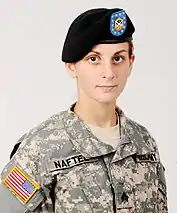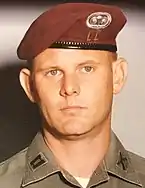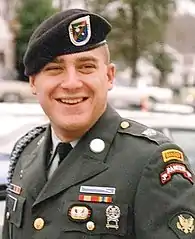Berets of the United States Army
The United States Army has used berets as headgear with various uniforms beginning in World War II. Since June 14, 2001, a black beret is worn by all U.S. Army troops unless the soldier is approved to wear a different distinctive beret. A maroon beret has been adopted as official headdress by the Airborne forces, a tan beret by the 75th Ranger Regiment, a brown beret by the Security Force Assistance Brigades, and a green beret by the Special Forces
In 2011, the Army replaced the black wool beret with the patrol cap as the default headgear for the Army Combat Uniform.[1][2][3]
History
In the United States military, the beret was unofficially worn by a variety of special operations units during and following World War II. In the spring of 1951, the 10th and 11th Ranger Companies wore black berets during their training at Camp Carson, Colorado, before their deployment to Japan.
In the post-Vietnam era, morale in the U.S. Army waned. In response, from 1973 through 1979 Headquarters, Department of the Army (HQDA), permitted local commanders to encourage morale-enhancing uniform distinctions. Consequently, many units embraced various color berets, for example armor and armored cavalry units often adopted the black beret. Similarly, many other units embraced various colored berets in an attempt to improve dwindling morale. In particular, the First Cavalry Division assigned various colored berets to its three-pronged TRICAP approach. In this implementation, armored cavalry, airmobile infantry units, air cavalry units, division artillery units, and division support units all wore different colored berets, including black, light blue, kelly green, and red.
Black




A black beret was authorized for wear by female soldiers in 1975, but was of a different design than men's berets. It was unofficially worn by some armored, armored cavalry, and some other troops. Today, the black beret is worn by regular soldiers of the U.S. Army.[7]
On January 30, 1975, it was officially allowed to be worn by the newly created battalions of United States Army Rangers who had worn it unofficially during the Vietnam War. In 1978, Army Chief of Staff Bernard Rogers required all units to adhere to the uniform regulation AR 670-1, which had not been updated to authorize the black beret for Rangers. In 1979 the new Army chief of staff, GEN Edward C. Meyers, directed that the black beret be authorized wear by Ranger units only. AR 670-1 was updated in 1980 to include this provision.
In 2001, the black beret became the primary headgear for both the service uniform (in garrison setting) and dress uniform for all United States Army troops unless the soldier is approved to wear a different distinctive beret. In 2011, the Army changed back to the patrol cap for primary wear with the utility uniform, with the beret remaining the headgear for the dress uniform.[8]
Brown

The brown beret was created in 2018 for soldiers of the U.S. Army's then-new Security Force Assistance Command and it's brigades or SFABs.[9] Soldiers assigned to the command and its brigades are authorized to wear the brown beret—with a brigade specific beret flash and distinctive unit insignia (DUI)—to recognize these new specialized units whose core mission is to conduct training, advising, assisting, enabling, and accompanying operations with allied and partner nations. According to an official U.S. Army article, "SFAB soldiers will be on the ground with their partners - fighting side-by-side with them in all conditions, so the brown beret symbolizes dirt or mud akin to the 'muddy boots' moniker given to leaders who are always out with the troops."[10]
Maroon


In 1943 General Frederick Browning, commander of the British First Airborne Corps, granted a battalion of the U.S. Army's 509th Parachute Infantry Regiment honorary membership in the British Parachute Regiment and authorized them to wear British-style maroon berets. During the Vietnam War, U.S. military advisers to Vietnamese airborne units often wore the Vietnamese French-style red beret.
HQDA policy from 1973 through 1979 permitted local commanders to encourage morale-enhancing distinctions. Airborne forces chose to wear the maroon beret as a mark of distinction. This permission was rescinded in 1979 when the army Chief of Staff, GEN Bernard Rogers, required all units to adhere to the uniform regulation (AR 670-1). On 28 November 1980, the updated regulation authorized airborne (parachute) organizations to resume wearing the maroon beret. In the interim, airborne units wore baseball caps with silver wings and the oval flash above the rank badge with the fatigue uniform, and the overseas cap with glider and parachute patch with the dress green uniform.
Tan


On 14 June 2001, U.S. Army Rangers assigned to the 75th Ranger Regiment and the Airborne and Ranger Training Brigade were authorized to wear a distinctive tan beret to replace the black berets that had recently become the army-wide standard. The color was chosen by the members of the 75th Ranger Regiment as being similar to other elite units with similar missions worldwide, notably the British, Australian and New Zealand Special Air Service regiments.
The change in color also required modification of the associated beret flashes worn by the Ranger units, changing the borders from white to black in order to provide better contrast to the lighter beret.

Original 75th Ranger Regiment Beret Flash 
Current 75th Ranger Regiment Beret Flash
Green


In the United States Army, the green beret may be worn only by soldiers awarded the Special Forces Tab, signifying they have qualified as Special Forces soldiers.
U.S. Army Special Forces wear the green beret because of their link to the British Commandos of World War II. The first Ranger unit, commonly known as Darby's Rangers, was formed in Northern Ireland during the summer of 1942. On completion of training at the Commando Training Depot at Achnacarry Castle in Scotland, those Rangers had the right to wear the British Commando green beret, but it was not part of the regulation uniform at the time and was disallowed by the U.S. Army. [11]
The 10th Special Forces Group (Airborne) had many veterans of World War II and Korea in its ranks when it was formed in 1952. Members of the 10th SFG began to unofficially wear a variety of berets while training, some favoring the red or maroon airborne beret, the black beret, or the green commando beret. In 1953, a beret whose design was based on that of the Canadian Army pattern, and which was rifle-green in color, was chosen for wear by Special Forces units.
Their new headgear was first worn at a retirement parade at Fort Bragg on 12 June 1955 for Lt. Gen. Joseph P. Cleland, the now-former commander of the XVIII Airborne Corps. Onlookers thought that the commandos were a foreign delegation from NATO.[12]
In 1956 Gen. Paul D. Adams, the post commander at Fort Bragg, North Carolina, banned its wear, even though it was worn on the sly when units were in the field or deployed overseas. This was reversed on 25 September 1961 by Department of the Army Message 578636, which designated the green beret as the exclusive headgear of the Army Special Forces.[11]
When visiting the Special Forces at Fort Bragg on 12 October 1961, President John F. Kennedy asked Brig. Gen. William P. Yarborough to make sure that the men under his command wore green berets for the visit. Later that day, Kennedy sent a memorandum that included the line: '"I am sure that the green beret will be a mark of distinction in the trying times ahead".[13] By America's entry into the Vietnam War, the green beret had become a symbol of excellence throughout the U.S. Army. On 11 April 1962 in a White House memorandum to the United States Army, President Kennedy reiterated his view: "The green beret is a symbol of excellence, a badge of courage, a mark of distinction in the fight for freedom".[13] Previously, both Yarborough and Edson Raff had petitioned the Pentagon to allow wearing of the green beret, to no avail.[13]

Of historical note, an olive drab green beret was worn by artic–qualified soldiers of the U.S. Army's 172nd Infantry Brigade stationed in Alaska from 1973 to 1979 when the US Department of the Army's morale-enhancing order was in force and various colored berets began to be worn by numerous units and branches of the US Army.[11][14][6]
References
- Lopez, C. Todd (June 15, 2011). "ACU Changes Make Velcro Optional, Patrol Cap Default headgear". U.S. Army. Retrieved March 2, 2017.
- Pierce-Lunderman, Cursha (June 23, 2011). "Bye-Bye, Beret: Switch to Patrol Cap Brings Mixed Feelings". U.S. Army. Retrieved March 2, 2017.
- Shaughnessy, Larry (June 14, 2011). "Army Backtracks on Black Berets After More than a Decade of Debate". CNN. Retrieved March 2, 2017.
- Class A Service and Dress From Uniforms From 1970's-2000; US Army Medical Department, Office of Medical History; last modified 2 July 2009, last accessed 20 May 2020
- Airborne and Ranger Training Brigade (ARTB), Graduates, 1971, Class 11-1971, benning.army.mil, dated 1971, last accessed 13 June 2020
- US Army berets - blue, black, green, maroon, tan..., The US Militaria Forum, last accessed 16 October 2020
- p.223 Stanton, Shelby U.S. Army Uniforms of the Cold War 1948-1973 1994 Stackpole Books
- "Army dumps beret as official ACU headgear". Archived from the original on 2014-02-20.
- https://www.armytimes.com/news/your-army/2018/02/08/its-official-army-unveils-brown-beret-new-patch-for-military-advisers-sfab/
- 1st SFAB hosts activation ceremony; Heraldry announced, Army.mil, dated 8 February 2018, last accessed 2 March 2018
- "A Short History of the Use of Berets in the U.S. Army". Archived from the original on 24 June 2001.
- P.32, "Inside the Green Berets" by Charles Simpson III
- LeFavor, Paul (2013). US Army Special Forces Small Unit Tactics Handbook. Blacksmith Publishing. p. 90. ISBN 978-0-9895513-0-4.
- The Beret in U.S. Military Uniform History, The Balance Careers, by Rod Powers, updated 27 June 2019, last accessed 14 September 2019